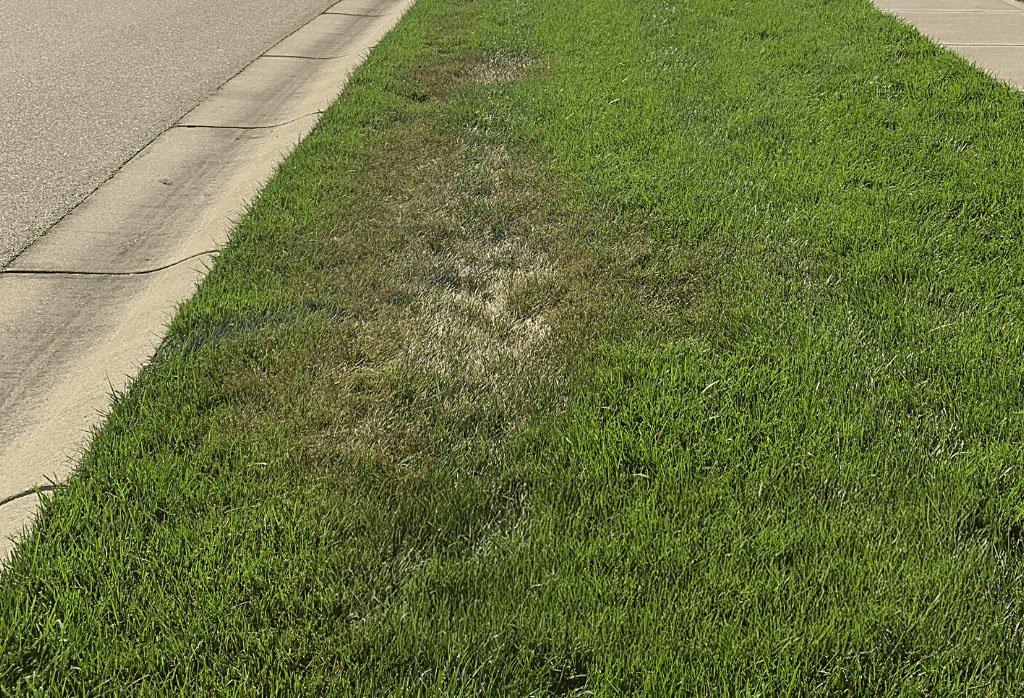Every year, right around the time temperatures swing, I start getting the same calls: “Something weird is happening to my lawn… is it dying?” And honestly, I get it. Lawn diseases don’t always show up loudly. Sometimes the earliest signs look like you missed a watering or left a sprinkler running too long. Other times it’s a sudden patch of discoloration that comes out of nowhere.
Working at Lawn Medic, I’ve seen just about every turf issue our climate can throw at a yard. Some are mild and pass quickly. Others can take out a lawn faster than most people expect. That’s why recognizing early symptoms matters – you can save yourself a lot of frustration (and a lot of grass).
Let me break down the most common diseases we see and what they typically look like.
Brown Patch: The One That Shows Up After Humid Nights
Brown patch is one of those sneaky diseases that loves warm, muggy evenings. You might wake up one morning and suddenly notice circular patches of tan or brown grass—almost like someone set down a giant hot pan on your lawn.
What makes it tough is how quickly it spreads. Sometimes within a day or two, you’ll see the affected area double. When homeowners are unsure whether they’re dealing with disease or drought stress, this one often ends up being the culprit.
The good news? With proper treatment – usually part of our standard lawn care services – you can stop brown patch before it does widespread damage.
Dollar Spot: Tiny Spots That Add Up Fast
The name gives it away. Dollar spot looks like someone scattered small, silver-dollar-sized spots across the lawn. At first, people often think it’s just sunburn or uneven watering. But if you look closer, the blades themselves have little straw-colored lesions.
This disease loves underfed lawns, especially when the turf is already stressed. I’ve seen it run through yards that look otherwise healthy simply because the grass wasn’t getting enough nutrients.
Keeping up with proper feeding – especially through our lawn fertilization program – makes a huge difference in preventing it.
Red Thread: The One You Notice and Say, “What on Earth Is That?”
Here’s a disease you can spot from the sidewalk. Red thread shows up as thin, reddish-pink strands that cling to the tips of grass blades. It almost looks like someone sprinkled yarn across the yard.
The funny thing? Even though it looks alarming, it’s usually not the most destructive disease. It tends to show up in lawns with low nitrogen or in seasons when growth slows down.
Most of the time, it clears up once the lawn gets proper nutrition. Still, if it lingers, we can address it as part of our seasonal lawn care treatments.
Snow Mold: The Surprise Waiting Under Melting Snow
Every spring, as snow finally melts away, we see a wave of calls about strange matted patches or grayish-white fuzz sitting on top of the grass. Snow mold is basically winter’s parting gift, and while most homeowners don’t see it coming, it’s incredibly common.
There are two kinds, gray and pink snow mold. Both thrive under long-lasting snow cover. While it often looks worse than it actually is, it can thin out turf and leave the lawn weak heading into spring.
A proper fall program, including the right feeding schedule, usually helps prevent the worst of it.
Summer Patch: The Silent Stress Booster
Summer patch tends to show up when heat and moisture combine at the root zone. Instead of discoloration on the blades, this disease attacks the roots themselves. That means you might not see anything until the grass starts collapsing in circular or crescent-shaped patches.
I tell homeowners all the time: if a lawn disease is going to sneak up on you, it’s this one.
Managing moisture, improving soil health, and keeping turf fed properly are all part of preventing summer patch. We build these steps into our lawn care services because once this disease takes root, recovery can take a while.
Why Early Detection (and a Good Program) Matters
The tricky thing about lawn diseases is how quickly they shift from “barely noticeable” to “this looks really bad.” By the time symptoms show up, the root cause has already taken hold. That’s why a consistent program makes such a big difference—it keeps your grass strong enough to fight off disease before you see it.
At Lawn Medic, our services aren’t just about curing diseases; they’re about creating a healthier lawn that naturally resists them. Whether it’s lawn fertilization, routine monitoring, or season-specific applications, the goal is the same: keep your turf resilient all year long.
If something in your yard seems off—even a small patch—don’t wait for it to spread. We see these problems every day, and catching them early can save your lawn from a long road back.

